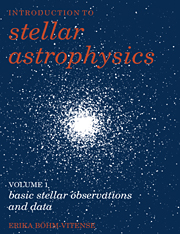Book contents
- Frontmatter
- Contents
- Preface
- 1 Positions of stars
- 2 Proper motions of stars
- 3 Distances of nearby stars
- 4 The brightnesses of the stars
- 5 Color magnitude diagrams
- 6 The luminosities of the stars
- 7 Angular radii of stars
- 8 Effective temperatures of stars
- 9 Masses and radii of stars
- 10 Spectral classification
- 11 Understanding stellar spectra
- 12 Population II stars
- 13 Stellar rotation
- 14 Stellar magnetic fields
- 15 Stars with peculiar spectra
- 16 Pulsating stars
- 17 Explosive stars
- 18 Our sun
- 19 Interstellar absorption
- Appendixes
- References
- Index
9 - Masses and radii of stars
Published online by Cambridge University Press: 04 August 2010
- Frontmatter
- Contents
- Preface
- 1 Positions of stars
- 2 Proper motions of stars
- 3 Distances of nearby stars
- 4 The brightnesses of the stars
- 5 Color magnitude diagrams
- 6 The luminosities of the stars
- 7 Angular radii of stars
- 8 Effective temperatures of stars
- 9 Masses and radii of stars
- 10 Spectral classification
- 11 Understanding stellar spectra
- 12 Population II stars
- 13 Stellar rotation
- 14 Stellar magnetic fields
- 15 Stars with peculiar spectra
- 16 Pulsating stars
- 17 Explosive stars
- 18 Our sun
- 19 Interstellar absorption
- Appendixes
- References
- Index
Summary
General discussion of binaries
For the stars for which angular diameters have been measured we can, of course, determine the radii by multiplying the angular radius by the distance to the star, provided we know the distance. For stars further away than about 20 pc we cannot measure trigonometric parallaxes accurately, we can therefore determine distances only in indirect ways. Star stream parallaxes (see for instance Becker, 1950) have been used to determine the distance to the Hyades cluster, but it turned out that the photometric parallaxes were more accurate. Fortunately, we can also determine radii for stars in special binary systems, namely in eclipsing binaries. For these binaries we can also determine the masses of the stars. We shall therefore devote this section to the discussion of binaries in general, and the next sections to the discussion of the special types of binaries for which stellar radii can be determined, namely eclipsing binaries, and for those binaries for which stellar masses can also be determined, again the eclipsing binaries and also the visual binaries.
We can determine stellar masses for binaries using Kepler's third law. Let us briefly discuss the mechanics of a binary system.
From the solar system we are accustomed to the case that one body, the sun, has a much larger mass than the other bodies, the planets. For binaries with two stars we have to take into account that both bodies have elliptical (or perhaps circular) orbits around their center of gravity S (see Fig. 9.1).
- Type
- Chapter
- Information
- Introduction to Stellar Astrophysics , pp. 67 - 88Publisher: Cambridge University PressPrint publication year: 1989



